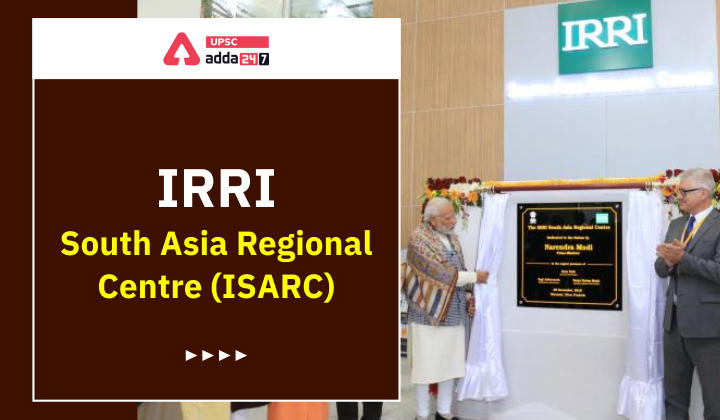Table of Contents
IRRI South Asia Regional Centre (ISARC)- Relevance for UPSC Exam
- GS Paper 2: International Relations- Important International institutions, agencies and fora- their structure, mandate.
IRRI South Asia Regional Centre (ISARC) in News
- Recently, a MoA was signed between the Department of Agriculture & Farmer Welfare (DA&FW) and International Rice Research Institute (IRRI) on commencement of Phase -2 activities of IRRI South Asia Regional Centre (ISARC).
- MoA aims to scale up the existing partnership for food and nutrition security in the South Asian region.
IRRI South Asia Regional Centre (ISARC)
- About: The ISARC was established following the Union Cabinet approval five years ago. ISARC is the first and biggest research Centre of the IRRI across the world outside Philippines.
- CERVA by ISARC: ISARC also set up a Centre of Excellence in Rice Value Addition (CERVA) that includes a modern and sophisticated laboratory with capacity to determine quality and status of heavy metals in grain and straw.
- Achievements: One of the critical achievements of CERVA is the development of one low and one intermediate glycaemic index (GI) rice varieties: IRRI 147 (GI 55) and IRRI 162 (GI 57), respectively.
- Significance: Since most rice varieties are high in GI and most of the Indians consume rice, the popularization of low GI rice varieties will reduce or even reverse India’s increasing trend of diabetes.
- Speed Breeding Facility (SpeedBreed): The Prime Minister Shri Narendra Modi inaugurated state-of-the-art Speed Breeding Facility (SpeedBreed) at ISRAC in Varanasi in 2021.
- The facility is devoted to expedite the plant growth cycle of crops and enable advancing rice plants for five generations per year against only one to two under normal conditions.
- This plays a crucial role in transferring important traits (e.g., low GI, biotic and abiotic stresses) to popular Indian rice varieties in a shorter time.
Micro Irrigation System: Definition, Types, Advantages, Disadvantages
Key Role of ISARC
- ISARC proposes to extend its research and development with the aim to accelerate the equitable development of sustainable and inclusive rice-based systems across India and South Asia to meet the producers’ and consumers’ demand.
- ISARC also plans to facilitate further improvement of system productivity and farmers’ income through digital agriculture, agro-advisory services, knowledge sharing and capacity development.
- These will promote sustainable and eco-friendly agriculture through business models that attract the youth back into Agri-entrepreneurship.
Second Phase of the ISARC Programme
- The second phase of the ISARC programme proposes to increase farmers’ incomes, improve food and nutrition security, health, and well-being of small/holder farmers.
- This is to be achieved through-
- Increased system productivity,
- Reduced yield gaps,
- Enhanced climate resilience,
- Mechanized and digital farming,
- Improved market linkages,
- Modernized value chains enabling entrepreneurship for women and youth, and
- Capacity development.
- Key Themes: 2nd Phase of ISARC Programme will be carried out through a trans disciplinary approach and leveraging cutting-edge technologies in three thematic areas over 5 years viz.-
- Centre of Excellence in Rice Value Addition (CERVA);
- Centre of Excellence in Sustainable Agriculture (CESA) and
- Center for Education in Innovation and Research for Development (CEIRD).
- Significance:
- It will pave the way for undertaking further work towards the improvement of the welfare of farmers and ensuring food and nutrition security in India and the rest of South Asia.
- It will also mitigate environment and climate change challenges in rice cultivation, help fight global hunger and eradicate poverty.
IRRI South Asia Regional Centre (ISARC)- Key Objectives
- Development, dissemination, and popularization of high-yielding stress-tolerant and bio-fortified rice, particularly high zinc and low glycemic index rice;
- Supporting national and regional rice breeding programmes to advance rice lines of specific and certified grain quality to increase producer and customer acceptance of new varieties to increase genetic gain;
- Promotion of climate-smart varieties, natural resource management practices, and resilient agriculture through integrated geospatial data systems and tools, robust seed systems, dynamic agro-advisory systems, and scale-appropriate mechanization;
- Improvement of nutrient use efficiency (NUE), soil health, and water productivity in diversified rice agri-food systems for increased productivity and reduced environmental footprints;
- Development of inclusive value chain-based business models (including farmer producer companies, business linkages, and entrepreneurship) for premium quality traditional varieties and value-added by-products;
- Development of evidence-based strategies to improve women’s economic empowerment through entrepreneurial engagement in rice-based systems and engaging youth in sustainable transformation of these systems; and
- Enhancement of local capacities, knowledge, and skills of all stakeholders through innovative human capital development solutions.
Rice Fortification in India: Activists Raises Health Concerns
Rice Fortification in India: Activists Raises Health Concerns





 TSPSC Group 1 Question Paper 2024, Downl...
TSPSC Group 1 Question Paper 2024, Downl...
 TSPSC Group 1 Answer key 2024 Out, Downl...
TSPSC Group 1 Answer key 2024 Out, Downl...
 UPSC Prelims 2024 Question Paper, Downlo...
UPSC Prelims 2024 Question Paper, Downlo...
